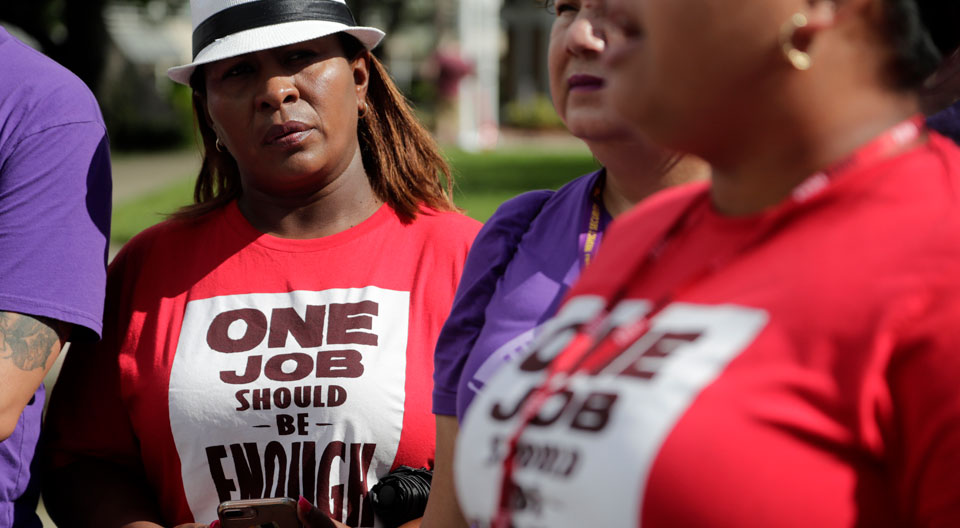
(EPI)—Twelve states and the District of Columbia have policies that increase (or index) their state’s minimum wage based on inflation. Most of those indexed increases are based on the August-to-August change in the Consumer Price Index, which will be announced sometime in mid-September.
With inflation higher than it has been in recent years, the indexed inflation increases in these states will be higher than usual as well. Still, these indexed increases are similar in size to other legislated minimum wage increases in recent years, and they will help reduce the burden of rising prices for low-wage workers and their families.
The federal minimum wage has remained at $7.25/hour for the past 15 years. Since then, its purchasing power, or real value, has dropped by 27% because of increases in the cost of living. As a result, the value of the minimum wage is the lowest since 1956.
In response, 30 states, Washington, D.C., and dozens of local governments have introduced their own minimum wages that are higher than the federal minimum wage. Workers in many of those states still experience the same problem—if the state doesn’t raise its minimum wage on a regular basis, its value will decline.
This challenge is particularly acute right now, as inflation is rising faster than worker wages. While EPI’s Nominal Wage Tracker shows wages are growing faster now than before the beginning of the pandemic, median real wages from February 2020 to June 2022 are down 1.1%. As food and energy prices continue to rise at double-digit levels, workers’ wages, in real terms, have declined.
Some state and local governments and the District of Columbia have opted to address this challenge by setting up automatic increases in the minimum wage indexed to the rate of inflation. This means that as prices rise, so do the wages of the lowest-paid workers.
Most states base their index value on the change from August of one year to August of the next year in the Consumer Price Index. That number hasn’t been released yet, but the July figure was 8.5%.
Some states follow different procedures.
- Minnesota and Vermont, for example, cap the annual increase at a maximum of 2.5% and 5%, respectively.
- Alaska’s increases are based off the preceding calendar year from when the determination of the next wage increase is made—that is, the 2022 increase was determined by the 2020 CPI. The 2023 increase will be based on the 2021 CPI, which Alaska is reporting to be 4.9%, though the state has not officially announced that the increase will be 4.9%.
- Oregon and Washington, D.C., whose minimum wages went up on July 1, both saw a 5.9% increase this year.
- Connecticut and Nevada are scheduled to introduce indexing to their minimum wages in 2024, though a ballot measure that Nevada voters will vote on this fall might remove that indexing.
Though the upcoming inflation-indexed adjustments to the minimum wage will likely be higher than in many previous years, they will not be out of line with past legislated increases in the minimum wage. When the federal minimum wage was raised from $5.15 to $7.25 in three steps in 2007, 2008, and 2009, the annual increases were 13.6%, 12.1%, and 10.7%, which are significantly larger than what is happening now because of indexing.
For example, Oregon and Washington, D.C., raised their minimum wage by 5.9% on July 1 because of inflation indexing, and Connecticut and Nevada both raised their minimum wages by about 7.7% through legislation. The new inflation-indexed increases also represent a much smaller labor cost increase for employers than the headline numbers suggest because employers are already increasing wages for some workers at the bottom.
In a world with higher prices, low-wage workers desperately need stronger labor standards in order to make ends meet. EPI’s Family Budget Calculator shows that there is nowhere in the country where a worker making $15 an hour earns enough to meet the requirements of a local family budget. Increasing the minimum wage is sound policy that supports working families and it’s popular: In a CBS News poll last Labor Day, a full 71% of respondents supported raising the minimum wage.
It is unfortunate that federal policymakers have been unable to pass legislation to set the minimum wage at an adequate level and then index it to keep pace with inflation. This should remain a policy priority, but state and local governments who have stepped in to raise the minimum wage and to protect workers from rising prices in the face of federal inaction have made the right decision.











